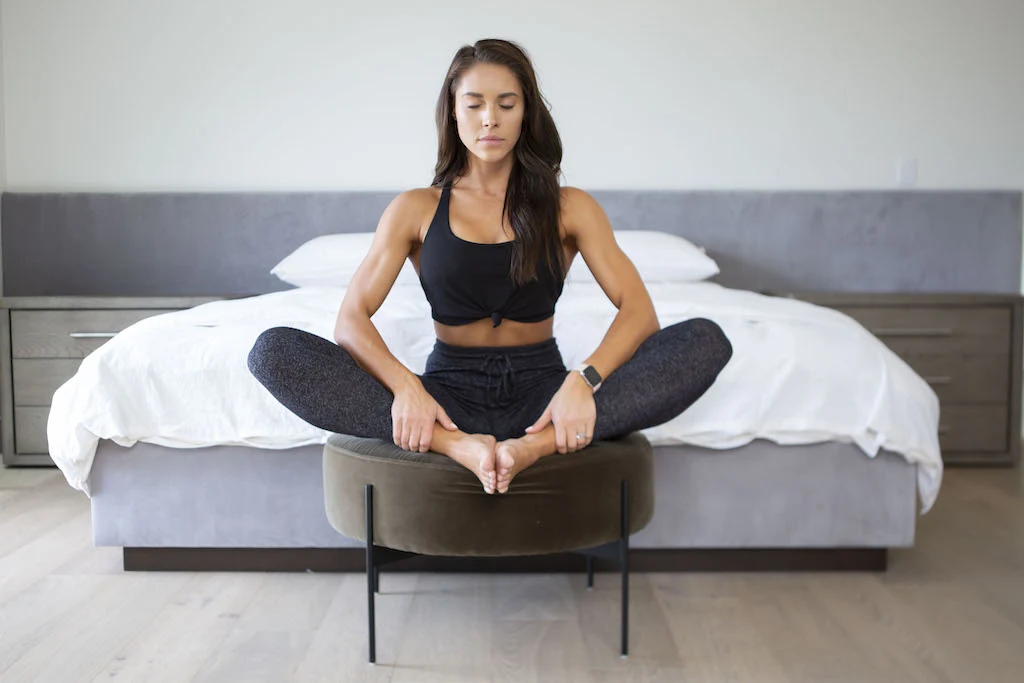A Guide To Getting Started With Mindfulness

October 11, 2019

Can mindfulness really help to improve your health and fitness? The practice has been much discussed as everything from a ‘cure-all’ for stress and a superficial ‘new-age’ theory.
The truth lies somewhere in between.
Mindfulness has become a buzzword, but it actually has a long history that predates its current popularity. Find out how it became a modern phenomenon and how you can use it as part of a balanced healthy lifestyle.
What is mindfulness?
According to Jon Kabat-Zinn, founder of the Mindfulness Based Stress Reduction Clinic in the US, mindfulness is a form of meditation that is about “paying attention, in a systematic way … to our present moment”.
He also makes the point that lots of us are actually focusing on the past or the future, instead of the current moment. In that sense, we’re missing out on what’s happening in our lives right now.
Meditation has a rich history across many cultures, including Chinese Taoist and Indian Buddhist traditions, over thousands of years.
Since the introduction of secular mindfulness-based stress reduction, mindfulness has become widely used as a stress management tool.
What is meditation?
Meditation provides time to get to know yourself better by observing your emotions, reactions, and thoughts with an attitude of curiosity and acceptance.
The purpose of meditation is to practice mindfulness in a structured way, enabling you to live in the moment more often during your daily life.
What are the benefits of mindfulness?
Mindfulness practice can help change the way we react to stressful events. Meditating is a way to observe our emotional responses, which then paves the way to changing patterns of behaviour and creating a greater sense of wellbeing.
Some research has shown that mindfulness may even help to slow the aging of the brain. Other benefits include:
Improved sleep
Better concentration
The ability to enjoy work
Letting go of the need for perfection
Self-forgiveness
Enhanced creativity
Healthier interpersonal interactions
Athletes use mindfulness to help to manage the emotional states that can impact their performance in competition.
Some of these include fear of failure, competition anxiety, perceived pressure and managing life-balance — issues that everyone with a passion for health and fitness can face!

How-to guide: getting started with mindfulness
If the thought of a long meditation session sounds too challenging, the good news is that you can take smaller steps towards mindful practice.
Here are a few ways to practice mindfulness in everyday life:
Become aware of your breathing. When you feel intense emotions, your breathing can change. Notice how this feels.
Pay attention to physical sensations like the feeling of water on your skin when you take a shower or the fabric of your clothing against your skin.
Remember throughout the day that your emotions and thoughts are temporary, they don’t have to define you.
Notice something new in your environment every day that you usually overlook. This could be the sound of birds in the morning, the features of the sidewalk you walk along each day, a smell. Be open to experience the world around you.
How do I know if I am doing it right?
Mindfulness is an intention and a continual practice. Being mindful doesn’t mean that you have to control your thoughts or suppress your feelings. All you need to do is be aware of the present.
When you practice mindfulness regularly, you may notice that you react more calmly to stressful situations. You may notice that your self-awareness improves, or that you experience fewer ‘ups and downs’ throughout your day or week.
Other signs that meditation is effective for you may include improved sleep and better focused attention span.
How does mindfulness help?
We generally relate to our present experiences based on what we’ve experienced in the past. Mindfulness can help you to experience the present more completely, without the fog of “interpretation” of the past.
By helping to bring your experiences into perspective, mindfulness can promote better emotional health. Some people use mindfulness to reduce stress, generate positive feelings and even improve memory and mental clarity.

What are some types of mindfulness or meditation I can try?
While there are plenty of meditation classes and meditation apps, you don’t need them to practice meditation.
Here are some simple meditation and mindfulness practices that you can try on your own.
Body scan
A body scan meditation is great for anyone who is on a fitness journey! This meditation can be done while sitting or lying.
1. Start the meditation by becoming aware of your breath, and then focus on one part of your body at a time.
2. You might start with your toes, arch of the feet, and so on, gradually working your way up to the top of your head.
3. Identify where you hold tension in the body and consciously release this tension. A good way to do this is to tense and release each muscle.
This meditation can be done at any time of day, but may also help you to relax for sleep.
Loving-kindness meditation
This meditation can help to boost your sense of well-being and reduce stress. When practiced regularly, it can increase your capacity for forgiveness, connection to others and self-acceptance.
1. Sit in a comfortable position, close your eyes and relax your muscles, taking a few deep breaths.
2. Imagine a feeling of complete physical and emotional peace and self-acceptance. You might choose to repeat a phrase to yourself, such as: “May I be happy, safe, healthy, peaceful and strong. May I give and receive appreciation today”.
3. When your attention drifts, bring it back to the current moment.
4. Repeat this process, directing this meditation towards someone close to you, and then to the wider population of your city or the world.
You can hold this feeling and return to it at any time throughout the day.
Breath meditation
This is a really simple meditation but it might take time to work up to five minutes of practice.
1. Find a comfortable position, ideally with your back upright.
2. Notice and relax your body, becoming aware of where it touches the air, your clothing or a chair.
3. Notice your breath and become aware of its flow in and out of your nose and throat. Notice whether your breathing is shallow, or whether your abdomen rises and falls.
4. When your mind wanders to other thoughts, redirect your awareness to your breathing.
5. Try to focus for five minutes.
This meditation can be challenging, but may become easier if you do it consistently.
Gratitude reflection
This is a simple meditation where you take a moment to ask: “What am I most grateful for?”. Don’t be judgemental about the answer, just allow it to arise and acknowledge what you feel gratitude for.
You might write the answer down in a gratitude journal or save it to share with a friend or family member. A gratitude practice is also a great way to introduce children to mindfulness.
Walking meditation
This alternative to sitting meditation is a practical way to relax. You can do walking meditation anywhere, by slowing your walking pace and focusing on the movement of your body. Bring your attention to how you lift your leg and place each foot for the next step.
Don’t focus on your destination, instead pay attention to how you move.
Mindful eating
Mindful eating is a practice that can help you form healthy eating habits and a greater awareness of and appreciation for your body.
Mindful eating can start when you sit down to a meal, or earlier when deciding what foods to purchase.
1. Before you begin to eat, consider how you feel within your body. Are you hungry? Thirsty? What emotions are you experiencing? This is the time to notice if you feel stressed, rushed or worried.
2. Eat slowly, without distraction. This means no TV, phone or other screens!
3. Appreciate the meal in front of you — the colours, textures and aromas of the food.
Try practicing mindful eating for one of your meals or snacks each day.
As you extend your mindful eating practice, you might also consider where the food has come from — the farm, supermarket, and the people involved in bringing the food to your plate.
Mindful listening
Have you ever found yourself thinking about what you are going to say next, rather than really listening to what someone is saying?
Practicing mindful listening is when you let go of the future, and rather than being caught up in your own thoughts, you listen openly and carefully to the other person.
Mindful listening can help to improve your interpersonal relationships, so that you respond without reactivity.

How much meditation should I do?
There are no scientific recommendations on how much meditation you should do.
However, as short meditation sessions can be effective, it is something you could try daily, at different times, to see what works for you. Creating a set routine for meditation may help you feel benefits from your practice.
One way to meditate is to create a list of inner peace quotes that are meaningful to you to reflect on at moments throughout the day.
Just like fitness, meditation takes practice and repetition. It should fit into your life comfortably, and it’s okay to change your practice to suit your changing lifestyle.
How can I experience the benefits of mindfulness meditation in my busy life?
Practising mindfulness and meditation is a bit like doing a workout. You can plan to do a workout, you can talk about it, you can even get into workout gear for a few hours. But if you don’t do the actual workout exercises, you won’t experience the benefits.
Like any other healthy habit, you only experience the real benefits of mindfulness if you set aside time to practice when you are free from distractions.
Trying to fit in meditation while you are “on-the-go” may not have the same benefits as if you set aside uninterrupted time each day.
Should I try mindfulness meditation?
Not all types of meditation will be appropriate for everyone. You should take a moment to gauge whether a particular type of meditation is working for you.
If you do run into difficulty when practising meditation, seek support from a healthcare professional.
The effects of mindfulness are subtle, so it might take time to see a change in how you feel, as compared to when you first start practising.
To determine if mindfulness meditation makes a difference to your overall wellbeing, try keeping a journal of how you feel and how you’re responding to different situations, including stressful ones, over time.
Try these mindfulness exercises as you continue your health and fitness journey
Practising mindfulness and meditation can help you to become more aware of your emotions and how your body feels. This can have benefits for your lifestyle and overall wellbeing too!
When you are tuned in to your body and mind, you can make smart calls about when to train harder or take a rest day. In the long run, this can lead to a more sustainable fitness journey and lasting results.
Do you have a mindfulness practice that you find useful? Share it in the comments below!

A more empowered you starts with Sweat, and our editorial team is here to bring you the latest fitness tips, trainer recommendations, wellbeing news, nutritional advice, nourishing recipes and free workouts.
* Disclaimer: This blog post is not intended to replace the advice of a medical professional. The above information should not be used to diagnose, treat, or prevent any disease or medical condition. Please consult your doctor before making any changes to your diet, sleep methods, daily activity, or fitness routine. Sweat assumes no responsibility for any personal injury or damage sustained by any recommendations, opinions, or advice given in this article.
Wellbeing